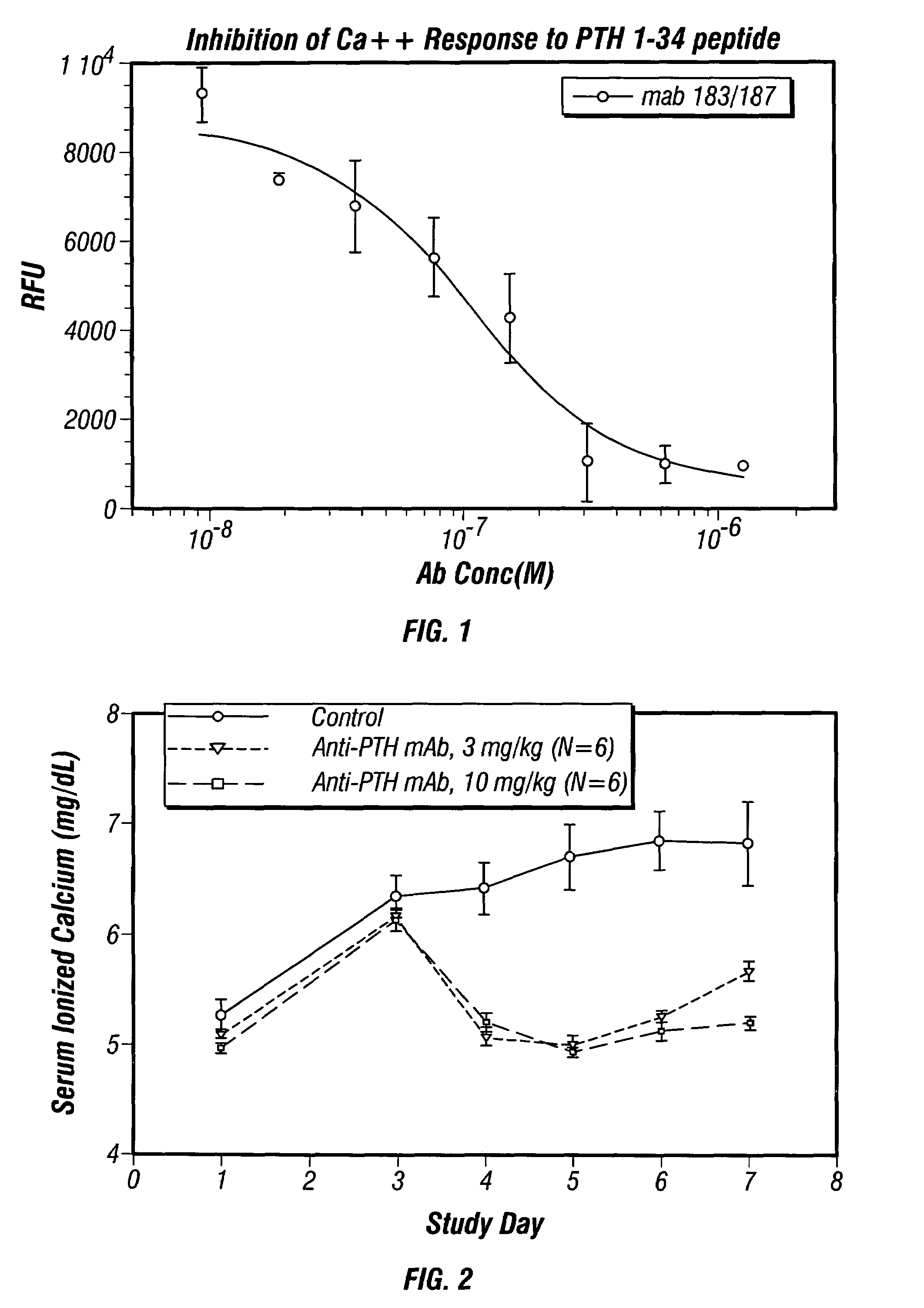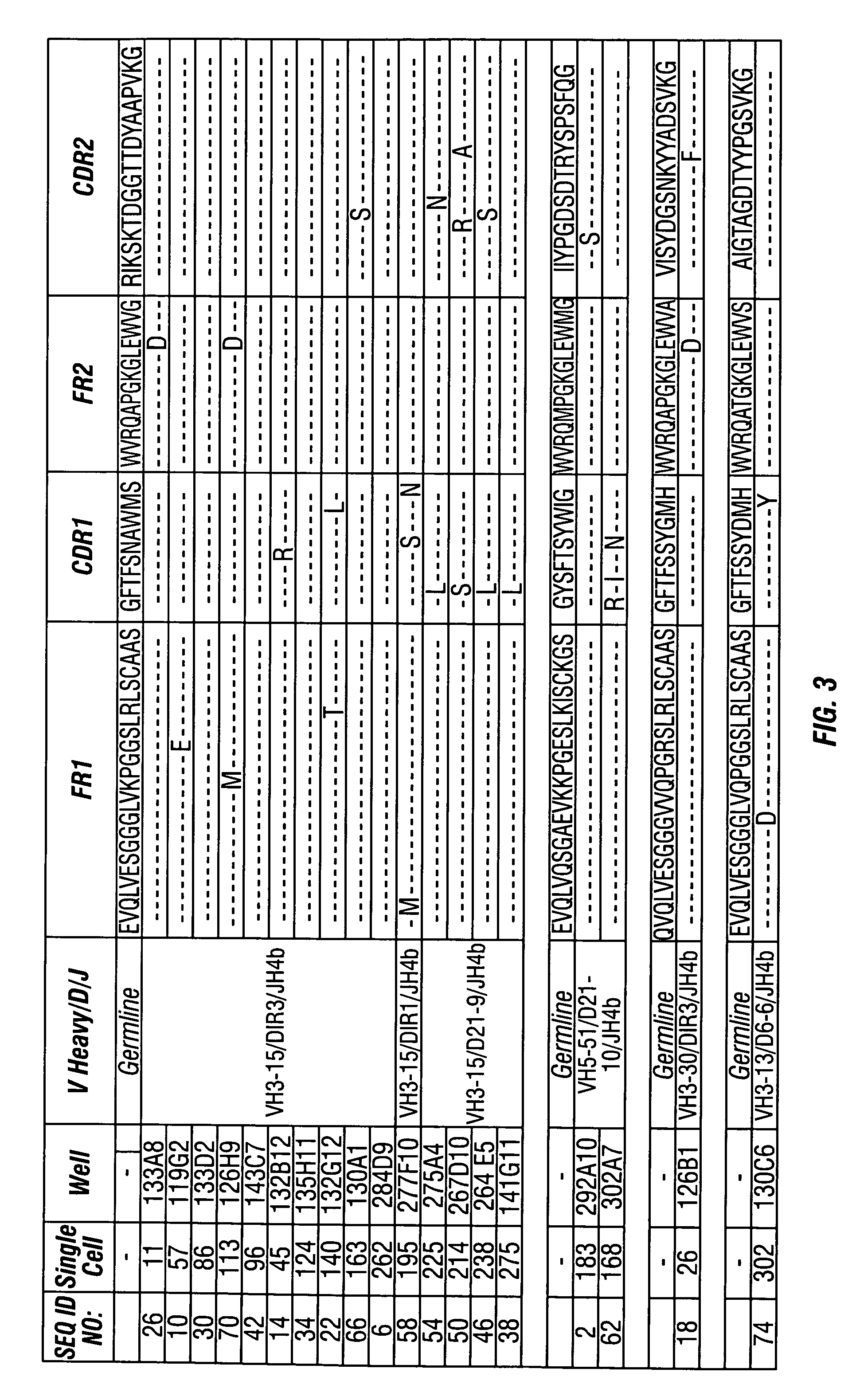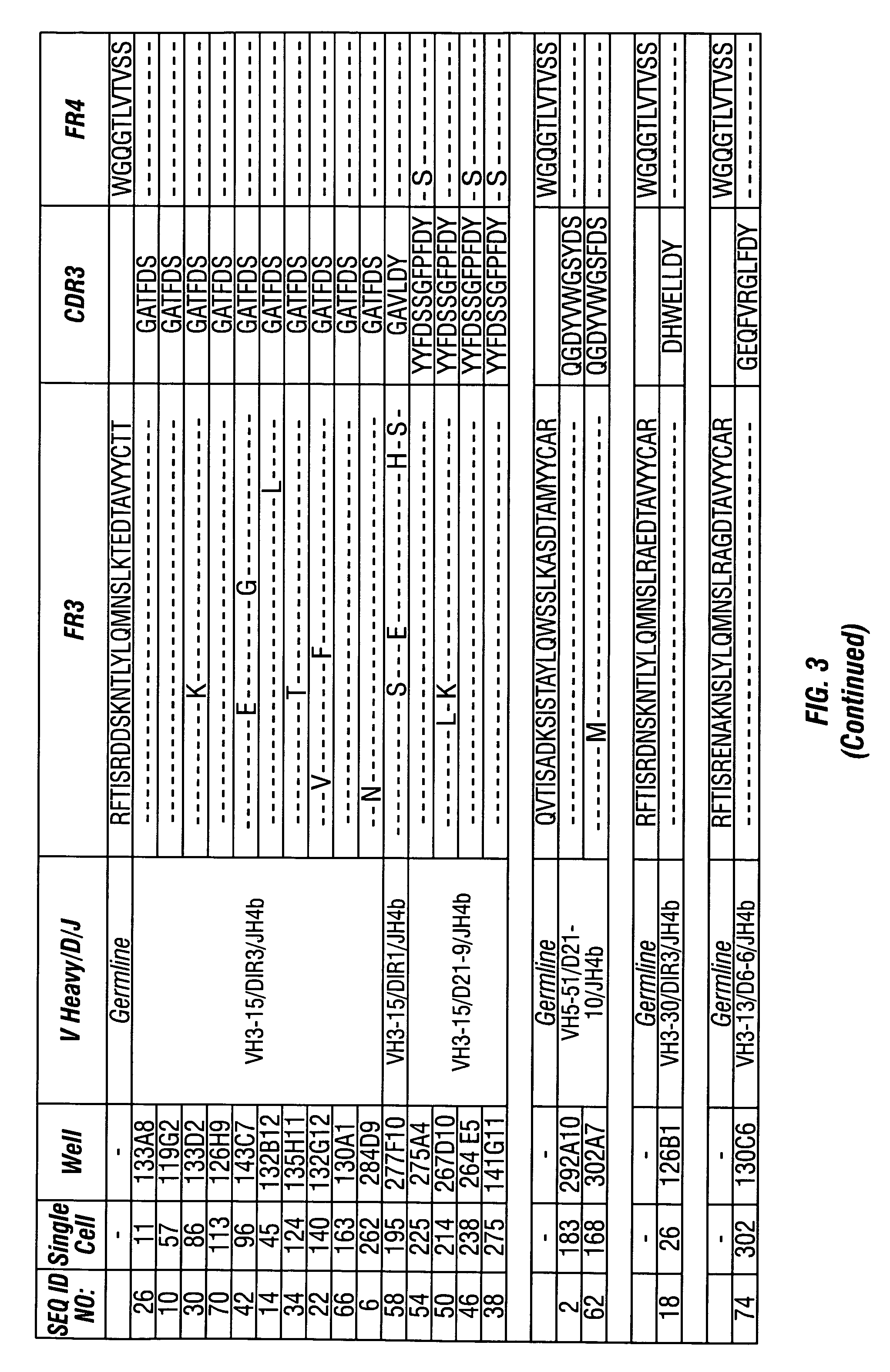Methods of use for antibodies against parathyroid hormone
a parathyroid hormone and antibody technology, applied in the field of parathyroid hormone antibodies, can solve the problems of relative inability to respond, inability to achieve satisfactory current medical management of primary hpt, formation of kidney stones, etc., and achieve the effect of prolonging the neutralization of pth in vivo
- Summary
- Abstract
- Description
- Claims
- Application Information
AI Technical Summary
Benefits of technology
Problems solved by technology
Method used
Image
Examples
example 1
PTH Antigen Preparation
[0160]The following PTH peptides were used in the experiments described herein.
[0161]
Human PTH (1-84):(SEQ ID NO: 81)SVSEIQLMHNLGKHLNSMERVEWLRKKLQDVHNFVALGAPLAPRDAGSQRPRKKEDNVLVESHEKSLGEADKADVNVLTKAKSQHuman PTH (1-34):(SEQ ID NO: 82)SVSEIQLMHNLGKHLNSMERVEWLRKKLQDVHNFHuman PTH (7-84):(SEQ ID NO: 83)LMHNLGKHLNSMERVEWLRKKLQDVHNFVALGAPLAPRDAGSQRPRKKEDNVLVESHEKSLGEADKADVNVLTKAKSQHuman PTH (18-48):(SEQ ID NO: 84)MERVEWLRKKLQDVHNFVALGAPLAPRDAGSHuman PTH-related peptide (1-34):(SEQ ID NO: 85)AVSEHQLLHDKGKSIQDLRRRFFLHHLIAEIHTARat PTH (1-84):(SEQ ID NO: 86)AVSEIQLMHNLGKHLASVERMQWLRKKLQDVHNFVSLGVQMAAREGSYQRPTKKEENVLVDGNSKSLGEGDKADVDVLVKAKSQRat PTH (1-34):(SEQ ID NO: 87)AVSEIQLMHNLGKHLASVERMQWLRKKLQDVHNFCynomolgus PTH (1-84):(SEQ ID NO: 88)SVSEIQLMHNLGKHLNSMERVEWLRKKLQDVHNFIALGAPLAPRDAGSQRPRKKEDNILVESHEKSLGEADKADVDVLTKAKSQ.
[0162]These peptides were purchased from Bachem California Inc., Torrance, Calif. Cynomolgus PTH (1-84) was also purchased from CS Bio Company, Inc., S...
example 2
Anti-PTH Antibodies
Antibody Generation
[0164]Immunization of animals. Monoclonal antibody against PTH was developed by sequentially immunizing XenoMouse® mice (XenoMouse® XG2, Abgenix, Inc. Fremont, Calif.). Synthetic 34mer human and rat PTH (50 / 50) coupled to KLH as described above was used as the antigen. The initial immunization was with 10 μg of antigen mixed 1:1 v / v with Complete Freund's Adjuvant (CFA, Sigma, Oakville, ON) per mouse. Subsequent boosts were made first with 10 μg of antigen admixed 1:1 v / v with Incomplete Freund's Adjuvant (IFA, Sigma, Oakville, ON) per mouse, followed by three injections with 10 μg of antigen mixed 1:1 v / v with IFA, and then a final boost of 10 μg of antigen admixed 1:1 v / v with IFA per mouse. In particular, each mouse was immunized at the base of the tail by subcutaneous injection. The animals were immunized on days 0, 14, 28, 42 and 54. The animals were bled on day 49 to obtain sera for harvest selection as described below.
[0165]Selection of a...
example 3
Structural Analysis of Anti-PTH Antibodies
[0203]The variable heavy chains and the variable light chains for the antibodies shown in Table 1 above were sequenced to determine their DNA sequences. The complete sequence information for all anti-PTH antibodies are shown in the sequence listing submitted herewith, including nucleotide and amino acid sequences for each gamma and kappa chain combination.
[0204]The variable heavy chain nucleotide sequences were analyzed to determine the VH family, the D-region sequence and the J-region sequence. The sequences were then translated to determine the primary amino acid sequence and compared to the germline VH, D and J-region sequences to assess somatic hypermutations. The primary amino acid sequences of all the anti-PTH heavy chains are shown in FIG. 3. The germline sequences are shown above and the mutations are indicated with the new amino acid sequence. Amino acids in the sequence that were identical to the indicated germline sequence are ind...
PUM
| Property | Measurement | Unit |
|---|---|---|
| dissociation constant | aaaaa | aaaaa |
| dissociation constant | aaaaa | aaaaa |
| molecular weight | aaaaa | aaaaa |
Abstract
Description
Claims
Application Information
 Login to View More
Login to View More - R&D
- Intellectual Property
- Life Sciences
- Materials
- Tech Scout
- Unparalleled Data Quality
- Higher Quality Content
- 60% Fewer Hallucinations
Browse by: Latest US Patents, China's latest patents, Technical Efficacy Thesaurus, Application Domain, Technology Topic, Popular Technical Reports.
© 2025 PatSnap. All rights reserved.Legal|Privacy policy|Modern Slavery Act Transparency Statement|Sitemap|About US| Contact US: help@patsnap.com



